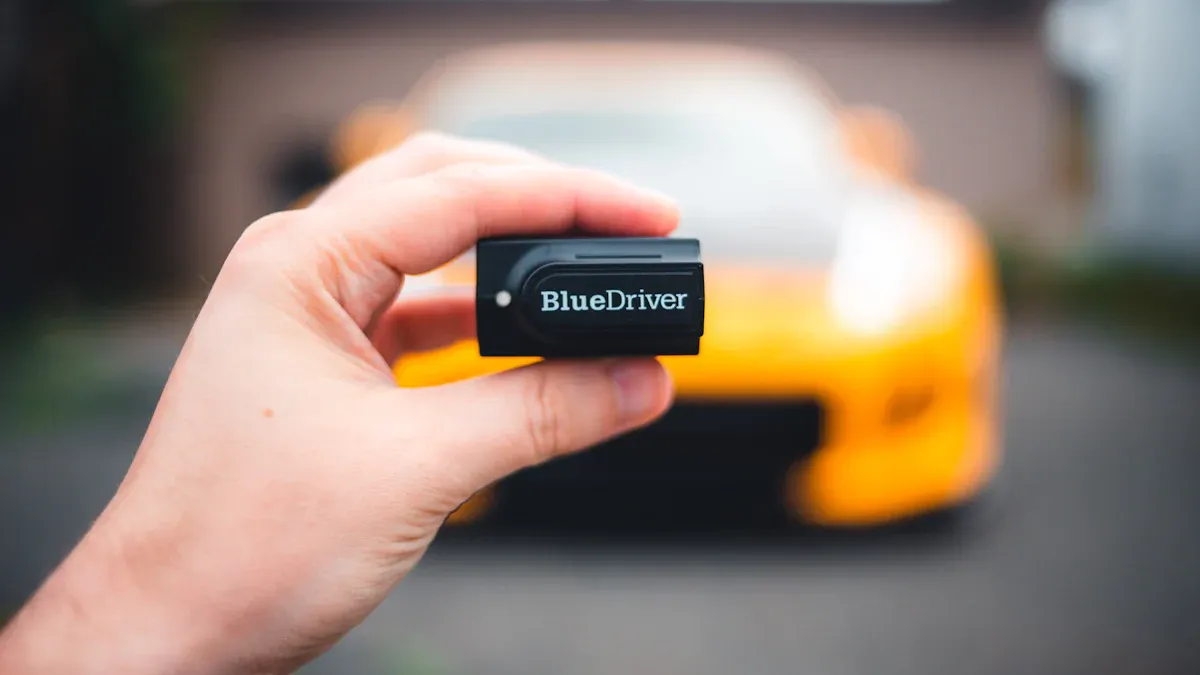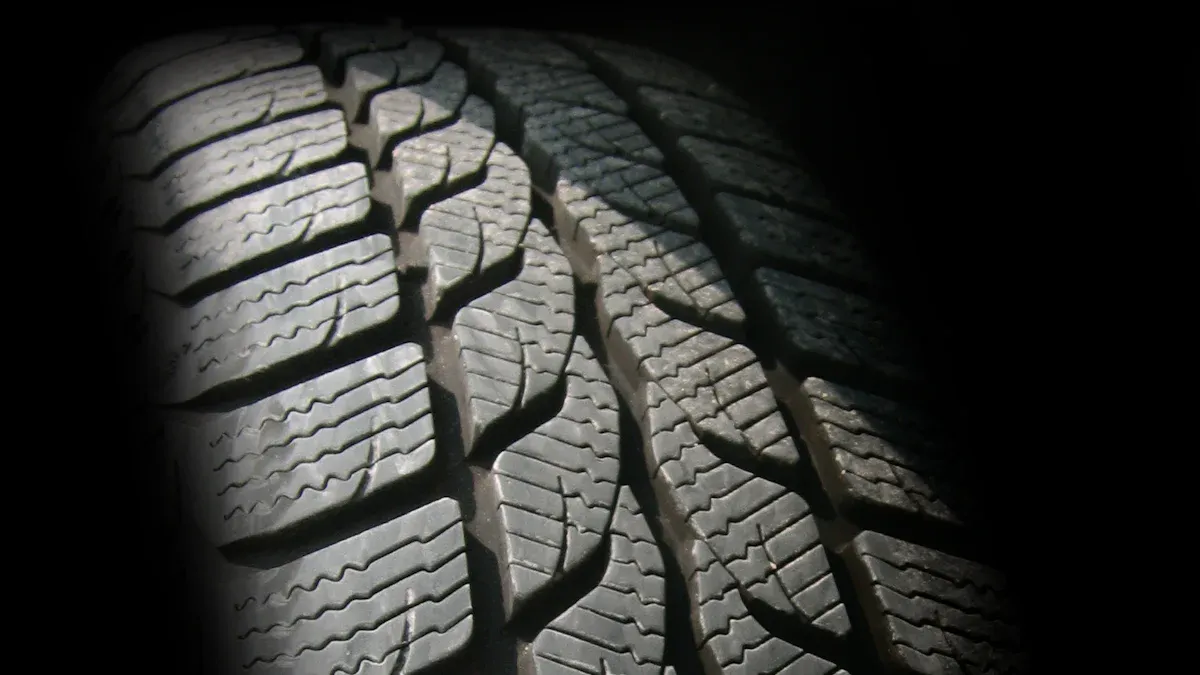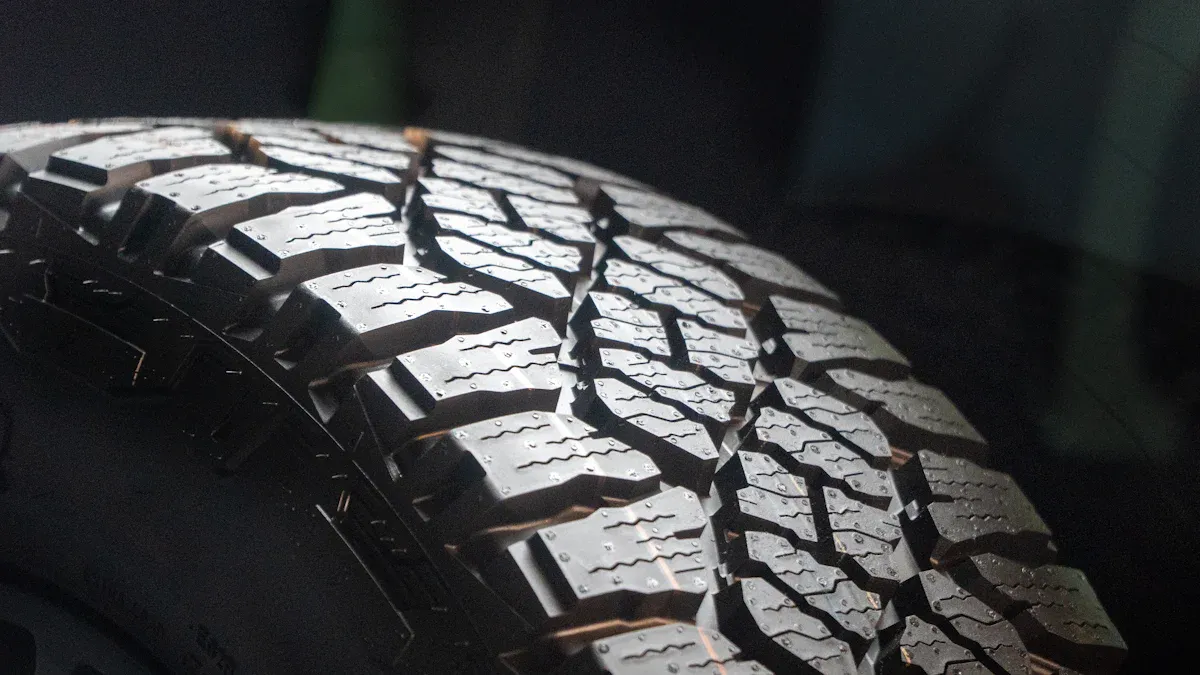
Nøjagtig måling af dækmønsterdybde er meget vigtigt. Det hjælper med at forhindre punkteringer. Slidte dæk kan forårsage farlige problemer på vejen. Håndholdte dækmønsterscannere gør disse målinger meget bedre. De giver hurtige og præcise data. Dette er svært at opnå med manuelle metoder. Deres lille størrelse gør dem nemme at bruge overalt. Disse scannere kan kontrollere dækkets tilstand selv. De foreslår også nødvendig vedligeholdelse. Dette niveau af nøjagtighed af truckdækmønsterscanner hjælper dig med at holde dine dæk sikre og pålidelige.
Vigtige punkter
Tjek dækmønsterdybden ofte for at undgå punkteringer og forblive sikker på vejen.
Brug håndholdte dækmønsterscannere til hurtige og præcise målinger. Dette hjælper med bedre vedligeholdelse.
Hold dækkene korrekt oppumpede og styr belastninger for at få dækkene til at holde længere og fungere bedre.
Opsæt en regelmæssig vedligeholdelsesplan for at kontrollere dækkets tilstand og løse problemer tidligt.
Manglende opmærksomhed på mønsterdybde kan forårsage juridiske problemer og alvorlige sikkerhedsrisici, som flere ulykker.
Hvorfor Dækmønsterdybde er vigtigt

Sikkerhedsrisici ved slidte dæk
Dækmønsterdybde er meget vigtigt for din sikkerhed på vejen. Når dækkene bliver slidte, kan de ikke gribe vejen godt. Dette kan forårsage alvorlige problemer:
Risici for vandplaning: Slidte dæk kan ikke skubbe vand væk, hvilket gør det lettere at miste vejgreb.
Overdreven varmeudvikling: Mindre mønster betyder, at dækkene ikke kan køle ned ordentligt, hvilket kan få dem til at svigte.
Nedsat håndtering i sne og is: Slidte dæk har svært ved at gribe i vintervejr, hvilket risikerer tab af kontrol.
Lufttryksproblemer: Slidte dæk kan miste luft hurtigt, hvilket påvirker håndtering og sikkerhed.
Øget Sandsynlighed for Dækeksplosioner: Slidte dæk har mindre materiale, hvilket gør dem lettere at punktere og få til at eksplodere.
Husk, at det at holde den rigtige mønsterdybde ikke kun handler om regler; det handler om din sikkerhed og andres på vejen.
Indvirkning på Bremselængde
Manglende tilstrækkelig mønsterdybde kan virkelig ændre, hvor hurtigt du kan stoppe en lastbil med semitrailer. Her er nogle vigtige punkter at tænke over:
Manglende mønsterdybde sænker trækkraften, hvilket er nøglen til at stoppe en lastbil med semitrailer.
Det øger risikoen for vandplaning, hvilket gør det længere tid at stoppe.
Dæk med mindre mønsterdybde kan forårsage tab af kontrol, hvilket gør det sværere at styre og stoppe ordentligt.
Den minimale lovbestemte mønsterdybde for semitrailordæk i Danmark er:
Dæktype | Minimum Dækmønsterdybde |
|---|---|
Styredæk | |
Alle andre dæk | 2/32 tommer |
At kende disse ting kan hjælpe dig med at træffe smarte valg om dækspleje. Tjek af mønsterdybde regelmæssigt kan forhindre farlige situationer og holde dig sikker på vejen.
Lastbil Dæk Mønsterdybde Scanner Nøjagtighed
Håndholdte dækskannere bruger smart teknologi til at give præcise målinger. Disse værktøjer har ændret sig meget i de senere år. De har nu funktioner, der gør dem mere nøjagtige og nemmere at bruge.
Teknologien Bag Skannere
Moderne håndholdte dækskannere bruger ofte laser scanning. Denne metode sender lys på dækket, som reflekteres tilbage til skanneren. Skanneren laver derefter 3D-data, der viser dækkets form. Denne teknologi gør det muligt at få præcise målinger hurtigt, normalt på få sekunder.
En anden smart metode bruger kameraet på en almindelig mobil enhed. Virksomheder som Anyline har lavet løsninger, der bruger intelligent computer vision og kunstig intelligens (AI) til at skabe en 3D-model af dækket. Dette giver dig nøjagtige digitale målinger, som du nemt kan gemme og dele.
Her er en opsummering af nogle teknologier, der bruges i disse scannere:
Teknologi Anvendt | Beskrivelse |
|---|---|
Gør det muligt hurtigt og nemt at måle dækkets sliddybde, hvilket forbedrer nøjagtigheden og pålideligheden. | |
Laser scanning | Giver præcise målinger ved at udsende lys på dækket og tolke de reflekterede data. |
AI og Maskinlæring | Muliggør dataanalyse i realtid og indsigt, hvilket forbedrer scannerens samlede funktionalitet. |
Fordele ved nøjagtige målinger
At opnå nøjagtige målinger fra håndholdte dækslidsmålere har mange fordele. Først og fremmest hjælper de dig med at finde slidte dæk, før de bliver farlige. Med AI-drevne platformekan disse scannere indsamle data fra dæk og køretøjer. Disse data hjælper med at forudsige vedligeholdelsesproblemer og hvor længe dækkene vil holde.
Derudover kan du bruge cloud-baserede dataportaler til realtids kontrol af slid på dækket. Denne funktion gør måling af sliddybde lettere og hurtigere. Du kan få daglige eller ugentlige opdateringer om dæk, der har brug for vedligeholdelse, hvilket forbedrer datanøjagtigheden og opdager tydelige slidmønstre.
Nøjagtigheden af disse scannere er fantastisk. De kan måle sliddybde med mindre end 0,2 mm (0,008 tommer) præcision. Dette niveau af nøjagtighed er bedre end gamle metoder og manuelle måleinstrumenter. Du kan stole på, at de unikke 3D-scanninger fra disse enheder viser komplette detaljer af dækkets tilstand.
Regelmæssige overvågningspraksisser
At have en regelmæssig vedligeholdelsesplan er meget vigtigt for at holde dine lastbilers dæk sikre og i god stand. Ved at tjekke sliddybde ofte kan du forhindre punkteringer og få dine dæk til at holde længere. Her er nogle gode praksisser at tænke på:
Daglige inspektioner: Tjek dine dæk før og efter ture. Se efter skader, punkteringer eller unormal slitage.
Ugentlige Kontroller: Mål lufttryk og mønsterdybde hver uge. Dette hjælper med at finde problemer, der kan forårsage dæksvigt.
Månedlige Gennemgange: Udfør detaljerede inspektioner hver måned. Roter og balancer dæk for at hjælpe dem med at slide jævnt og tjek den samlede hjultilstand.
Sæsonbestemte Vurderinger: Tilpas dine inspektioner baseret på vejforholdene. Sæsonkontroller hjælper dig med at forberede dig til vinter eller vådt vejr.
Husk, at pasning af dine dæk kan spare dig for penge på reparationer og holde alle sikre på vejen.
Etablering af en Vedligeholdelsesplan
At lave en dækværktøjsplan er nøglen for kommercielle flåder. Her er nogle trin til at skabe en god plan:
Tildel Ansvarsområder: Vælg teammedlemmer til at håndtere dækværktøjsopgaver. Dette hjælper med ansvarlighed og effektivitet.
Følg Op på Registre: Opbevar detaljerede optegnelser over alt vedligeholdelsesarbejde. Dette hjælper med at følge regler og opdage tendenser over tid.
Uddan Chauffører: Lær chauffører, hvorfor dækværktøj er vigtigt. Opfordr dem til at rapportere eventuelle problemer, de ser under deres daglige kontrol.
Justér Baseret på Data: Overvåg fremskridt og juster din vedligeholdelsesplan baseret på de data, du indsamler. Dette hjælper dig med at reagere på skiftende forhold.
Integrering af Scannere i Rutinekontroller
Håndholdte dækmønster-scannere kan virkelig forbedre dine rutinemæssige kontroller. De giver hurtige og præcise målinger, hvilket gør inspektioner lettere. Her er hvordan du bruger disse scannere i dine daglige eller ugentlige praksisser:
Funktion | Beskrivelse |
|---|---|
Mobil Datafangst | Muliggør hurtige og præcise målinger af dækmønsterdybde. |
Brugervenlig | Let at bruge uden meget træning, godt for teknikere og kunder. |
Effektivitet | Gør inspektionsprocessen hurtigere, hvilket sparer tid på kontroller. |
Med håndholdte scannere kan teknikere færdiggøre vurderinger på under fem sekunder pr. dæk. Denne hastighed forbedrer kundeservice og reducerer ventetider. For eksempel giver Anyline’s app flåder mulighed for hurtigt at scanne og forstå dækindata. Dette hjælper med at spore og håndtere dækkets tilstand bedre.
Ved at bruge disse teknologier i dine rutinetjek forbedrer du ikke kun nøjagtigheden, men hjælper også med at overholde reglerne. Transportministeriet (DOT) kræver en minimum dækmønsterdybde på 4/32 tommer for forhjul og 2/32 tommer for andre dæk på erhvervskøretøjer. Regelmæssige inspektioner med en måler eller penny-test anbefales for at sikre overholdelse.
Ved at oprette en stærk vedligeholdelsesplan og bruge avanceret teknologi kan du i høj grad reducere risikoen for punkteringer og forbedre sikkerheden for din flåde.
Bedste Dækvedligeholdelsespraksis

Visuelle Inspektioner
Regelmæssige visuelle tjek er meget vigtige for dæksikkerheden. Du bør udføre disse tjek for at opdage problemer tidligt. Her er en enkel tjekliste for at hjælpe dig med inspektionen:
Trin | Detaljer |
|---|---|
Sørg for, at styredæk har mindst 4/32″ og andre har 2/32″. | |
Dæktrykskontrol | Tjek kold dæktryk mod producentens anbefalinger. |
Se efter snit, buler og ujævn slitage. | |
Lugmøtrikstramhed | Kontroller, om lugmøtrikker og hjuldele er stramme. |
En god visuel inspektion hjælper dig med at finde problemer som flade dæk, skår, punkteringer og rifter. At opdage små problemer tidligt kan forhindre større skader senere. Ældre dæk kan få revner, hvilket betyder, at de er tæt på at være slidte.
For at holde dine dæk i god stand, følg denne rutine:
Før afgang: Sørg for, at dækkene er korrekt oppumpede, og tjek slidbanens dybde.
Under turen: Ved hver lastbilstop, tjek dækkets oppumpning, slidbanens dybde, og foretag en visuel inspektion.
Ved ankomst: Tjek dækkets oppumpning, slidbanens dybde, og foretag en visuel inspektion.
Korrekt oppumpning og laststyring
At holde den rette dæktrykket er nøglen til sikkerhed og ydeevne. Dæk, der ikke er tilstrækkeligt oppumpede, kan overophede og sprænge. De rører også mindre ved vejen, hvilket får dem til at slides hurtigere og øger risikoen for skred. Regelmæssig kontrol af dæktrykket hjælper dine dæk med at holde længere og reducerer risikoen for dæksvigt, da dæk, der ikke er korrekt oppumpede, mister slidbanen hurtigere.
Laststyring er også meget vigtig for dækkets helbred. Her er nogle nøglepunkter at tænke på:
Overbelastning af dæk kan få dem til at slides hurtigere og kræve flere reparationer eller udskiftninger.
Ekstra vægt forårsager varmeopbygning, hvilket kan ødelægge gummi og forårsage dæksvigt.
Ujævn fordeling af lasten fører til ujævn slidbane og påvirker, hvordan lastbilen håndteres.
Underoppumpede dæk under tunge belastninger fører til dårlig håndtering og mere slid.
Overoppumpning for at håndtere vægt kan forårsage trækkraftproblemer og skade slidbanen.
Tegn på overbelastning inkluderer bulende sidevægge, revner og ujævne slidmønstre. Ved at styre både oppumpning og last kan du i høj grad forbedre dæksikkerheden og deres levetid.
Husk, at tage disse skridt kan spare dig penge på reparationer og holde dig sikker på vejen.
Konsekvenser af at forsømme dækmønsterdybden
Juridiske konsekvenser
Ignorerer dæks sliddybde kan forårsage store juridiske problemer for lastbilfirmaer. Der er regler, der fastsætter minimum dækmønsterdybde for at holde vejene sikre. Her er et hurtigt overblik over disse regler:
Krav | Beskrivelse |
|---|---|
Minimum Dækmønsterdybde | 4/32 tommer på styreaksler; 2/32 tommer på alle andre aksler |
Genriving | Styredæk kan ikke genrives, recappes eller genbeklædes |
Lastvægtsklassificering | Skal matche eller overstige køretøjets frontale bruttoaksellast (GAWR) |
Dækmatchning | Alle dæk på samme aksel skal være af samme størrelse og type |
Hastighedsbedømmelse | Normalt 75 mph for de fleste kommercielle operationer |
Manglende overholdelse af disse regler kan føre til forskellige sanktioner. Du kan stå over for:
Bøder: En startbøde på $25 for dæk, der ikke opfylder standarderne, hvilket kan øges med flere kontroller.
Bilbeslaglæggelse: Dit køretøj kan blive taget, indtil du udskifter dækkene.
Ansvar: Du kan blive ansvarlig for skader eller tilskadekomst i ulykker forårsaget af dårlig mønsterdybde.
Risici for trafiksikkerheden
At ignorere dækmønsterdybden kan skabe alvorlige risici for trafiksikkerheden. Når mønsterdybden går under 2/32 tommer, bliver vejgrebet meget dårligere. Dette øger risikoen for punkteringer, hvilket kan forårsage frygtelige ulykker. Her er nogle vigtige punkter at tænke over:
God dækmønsterdybde er nøglen til at opretholde vejgreb, især når det er vådt.
Lav mønsterdybde kan forårsage hydroplaning, hvilket gør det lettere at miste kontrollen.
Slidte dæk gør det sværere at stoppe, hvilket er meget vigtigt for lastbiler med tunge læs.
Problemer ved manglende mønsterdybde inkluderer:
Højere risiko for dækpunktering, især ved høje hastigheder.
Større risiko for skred på grund af mindre vejgreb.
Længere bremselængde, hvilket kan føre til kollisioner.
Statistikker viser, at dæksproblemer forårsager 6% af alle store lastbilulykker, med 5.6% af alvorlige ulykker hovedsageligt på grund af dækpunktering. Ved at opretholde den rette mønsterdybde kan du i høj grad reducere disse risici og forbedre trafiksikkerheden.
Brug af håndholdte dæksporingsscannere hjælper dig i høj grad med at holde dine dæk sikre. Disse værktøjer giver dig præcise målinger. Dette hjælper dig med at finde problemer, før de forårsager punkteringer.
“Med denne teknologi og regelmæssige kontrol kan flåder holde deres dæk sunde. Dette sparer penge på brændstof og udskiftninger, forbedrer sikkerheden og får dækkene til at holde længere,” siger Maxey.
Brug af denne teknologi kan spare dig for mange penge. For eksempel kan du se brændstofbesparelser på 1% til 2% og øget dæklivslængde på 15% til 20%.
Fordel | Estimeret påvirkning |
|---|---|
Forbedring af brændstoføkonomi | |
Reduktion i nødopkald på vejen | 70% til 90% færre opkald |
Dæklængdeforlængelse | 15% til 20% længere |
Årlige besparelser pr. lastbil | $2,000 |
At købe håndholdte dæksporingsscannere forbedrer ikke kun sikkerheden, men hjælper også din flåde med at arbejde bedre. Brug denne teknologi for en sikrere og mere effektiv tur på vejen.
Ofte stillede spørgsmål
Hvad er den bedste dækmønsterdybde for semi-trucks?
Den bedste dækmønsterdybde for styredæk er 4/32 tommer. Andre dæk bør have mindst 2/32 tommer. At holde disse dybder hjælper med sikkerhed og overholdelse af regler.
Hvor ofte skal jeg tjekke min dækmønsterdybde?
Du bør tjekke din dækmønsterdybde hver uge. Regelmæssige kontroller hjælper dig med at opdage slid tidligt og forhindre punkteringer, hvilket gør ture sikrere.
Kan håndholdte scannere virkelig forbedre dæksikkerheden?
Ja! Håndholdte scannere giver præcise målinger af dækmønsterdybden. De hjælper dig med at finde slidte dæk, før de bliver et problem, hvilket gør tingene sikrere generelt.
Hvad er tegnene på slidte dæk?
Tegn på slidte dæk inkluderer ujævn slidning af mønsteret, revner, buler og lav mønsterdybde. Regelmæssige visuelle kontrol kan hjælpe dig med at opdage disse problemer tidligt.
Hvordan kan jeg få mine dæk til at holde længere?
For at få dækkene til at holde længere, skal du holde korrekt dæktryk, håndtere belastninger omhyggeligt og foretage regelmæssige kontrol. Disse trin hjælper med at forhindre tidligt slid og punkteringer.
Se også
Forståelse af smarte dækmønsterdybde detektorer og deres funktion
Vigtigheden af at overvåge mønsterdybden på dækkene for sikkerhed






